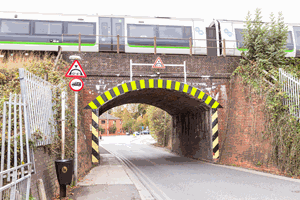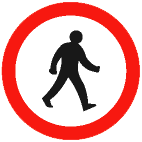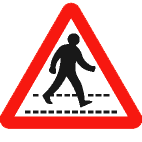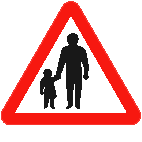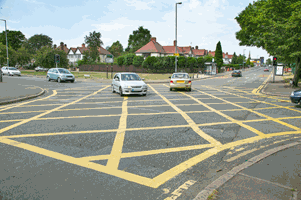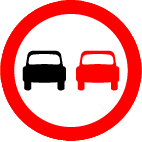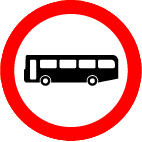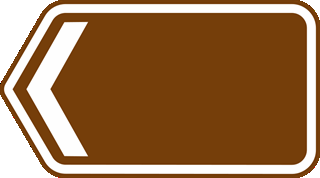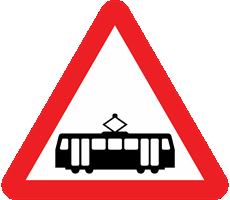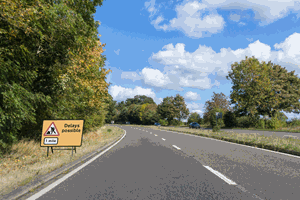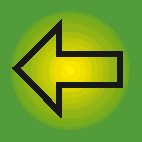You have 57 minutes to answer 50 multiple choice theory test questions. You need to answer at least 43 out of 50 questions correctly to pass. You can review your answer after each question or you can review all of your answers at the end of the test. Best of luck!
Test Quick View
Click on an answer to view the correct choice along with the explanation.
1. You are following a vehicle on a wet road. You should leave a time gap of at least
Mark one answer
B
C
D
Correct Answer: A
Explanation: Wet roads will reduce your tyres' grip on the road. The safe separation gap of at least two seconds in dry conditions should be doubled in wet weather.
Explanation: Wet roads will reduce your tyres' grip on the road. The safe separation gap of at least two seconds in dry conditions should be doubled in wet weather.
Correct Answer: C
Explanation: Traffic calming measures help keep vehicle speeds low in congested areas where there are pedestrians and children. A pedestrian is much more likely to survive a collision with a vehicle travelling at 20 mph than at 40 mph.
Explanation: Traffic calming measures help keep vehicle speeds low in congested areas where there are pedestrians and children. A pedestrian is much more likely to survive a collision with a vehicle travelling at 20 mph than at 40 mph.
Correct Answer: B
Explanation: A double-deck bus or high-sided lorry will have to take up a position in the centre of the road so that it can clear the bridge. There is normally a sign to indicate this. Look well down the road, through the bridge and be aware you may have to stop and give way to an oncoming large vehicle.
Explanation: A double-deck bus or high-sided lorry will have to take up a position in the centre of the road so that it can clear the bridge. There is normally a sign to indicate this. Look well down the road, through the bridge and be aware you may have to stop and give way to an oncoming large vehicle.
Correct Answer: D
Explanation: Always check the road signs. Triangular signs are warning signs and they'll keep you informed of hazards ahead and help you to anticipate any problems. There are a number of different signs showing pedestrians. Learn the meaning of each one.
Explanation: Always check the road signs. Triangular signs are warning signs and they'll keep you informed of hazards ahead and help you to anticipate any problems. There are a number of different signs showing pedestrians. Learn the meaning of each one.
5. You are turning left into a side road. What hazards should you be especially aware of?
Mark one answer
B
C
D
Correct Answer: C
Explanation: Make sure that you have reduced your speed and are in the correct gear for the turn. Look into the road before you turn and always give way to any pedestrians who are crossing.
Explanation: Make sure that you have reduced your speed and are in the correct gear for the turn. Look into the road before you turn and always give way to any pedestrians who are crossing.
Correct Answer: A
Explanation: Motorcycles are small vehicles and can be difficult to see. If the rider wears bright clothing it can make it easier for other road users to see them approaching, especially at junctions.
Explanation: Motorcycles are small vehicles and can be difficult to see. If the rider wears bright clothing it can make it easier for other road users to see them approaching, especially at junctions.
7. You are following a long vehicle. It approaches a crossroads and signals left, but moves out to the right. You should
Mark one answer
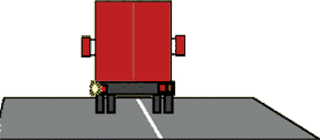
B
C
D
Correct Answer: D
Explanation: A lorry may swing out to the right as it approaches a left turn. This is to allow the rear wheels to clear the kerb as it turns. Don't try to filter through if you see a gap on the nearside.
Explanation: A lorry may swing out to the right as it approaches a left turn. This is to allow the rear wheels to clear the kerb as it turns. Don't try to filter through if you see a gap on the nearside.
8. You are approaching a mini-roundabout. The long vehicle in front is signalling left but positioned over to the right. You should
Mark one answer

B
C
D
Correct Answer: B
Explanation: At mini-roundabouts there isn't much room for a long vehicle to manoeuvre. It will have to swing out wide so that it can complete the turn safely. Keep well back and don't try to move up alongside it.
Explanation: At mini-roundabouts there isn't much room for a long vehicle to manoeuvre. It will have to swing out wide so that it can complete the turn safely. Keep well back and don't try to move up alongside it.
9. After a breakdown you need to rejoin the main carriageway of a motorway from the hard shoulder. You should
Mark one answer
B
C
D
Correct Answer: A
Explanation: Wait for a safe gap in the traffic before you move out. Indicate your intention and use the hard shoulder to gain speed but don't force your way into the traffic.
Explanation: Wait for a safe gap in the traffic before you move out. Indicate your intention and use the hard shoulder to gain speed but don't force your way into the traffic.
Correct Answer: A
Explanation: The purpose of this road marking is to keep the junction clear of queuing traffic. You may only wait in the marked area when you're turning right and your exit lane is clear but you can't complete the turn because of oncoming traffic.
Explanation: The purpose of this road marking is to keep the junction clear of queuing traffic. You may only wait in the marked area when you're turning right and your exit lane is clear but you can't complete the turn because of oncoming traffic.
11. Someone is waiting to cross at a zebra crossing. They are standing on the pavement. You should normally
Mark one answer
B
C
D
Correct Answer: D
Explanation: By standing on the pavement, the pedestrian is showing an intention to cross. If you are looking well down the road you will give yourself enough time to slow down and stop safely. Don't forget to check your mirrors before slowing down.
Explanation: By standing on the pavement, the pedestrian is showing an intention to cross. If you are looking well down the road you will give yourself enough time to slow down and stop safely. Don't forget to check your mirrors before slowing down.
Correct Answer: B
Explanation: The use of cycles is being encouraged and more toucan crossings are being installed. These crossings enable pedestrians and cyclists to cross the path of other traffic. Watch out as cyclists will approach the crossing faster than pedestrians.
Explanation: The use of cycles is being encouraged and more toucan crossings are being installed. These crossings enable pedestrians and cyclists to cross the path of other traffic. Watch out as cyclists will approach the crossing faster than pedestrians.
Correct Answer: A
Explanation: If you are driving a motor vehicle or riding a motorcycle you MUST NOT travel past this sign. This area has been designated for use by pedestrians.
Explanation: If you are driving a motor vehicle or riding a motorcycle you MUST NOT travel past this sign. This area has been designated for use by pedestrians.
Correct Answer: D
Explanation: Signs with a brown background give directions to places of interest. They will often be seen on a motorway directing you along the easiest route to the attraction.
Explanation: Signs with a brown background give directions to places of interest. They will often be seen on a motorway directing you along the easiest route to the attraction.
Correct Answer: C
Explanation: This sign warns you to beware of trams. If you don't usually drive in a town where there are trams, remember to look out for them at junctions and look for tram rails, signs and signals.
Explanation: This sign warns you to beware of trams. If you don't usually drive in a town where there are trams, remember to look out for them at junctions and look for tram rails, signs and signals.
Correct Answer: D
Explanation: Where traffic lights are out of order you might see this sign. Proceed with caution as nobody has priority at the junction.
Explanation: Where traffic lights are out of order you might see this sign. Proceed with caution as nobody has priority at the junction.
B
C
D
Correct Answer: C
Explanation: A toucan crossing is designed to allow pedestrians and cyclists to cross at the same time. Look out for cyclists approaching the crossing at speed.
Explanation: A toucan crossing is designed to allow pedestrians and cyclists to cross at the same time. Look out for cyclists approaching the crossing at speed.
Correct Answer: A
Explanation: In the interests of road safety, temporary speed limits are imposed at all major road works. Signs like this, giving advanced warning of the speed limit, are normally placed about three quarters of a mile ahead of where the speed limit comes into force.
Explanation: In the interests of road safety, temporary speed limits are imposed at all major road works. Signs like this, giving advanced warning of the speed limit, are normally placed about three quarters of a mile ahead of where the speed limit comes into force.
19. The red lights are flashing. What should you do when approaching this level crossing?
Mark one answer
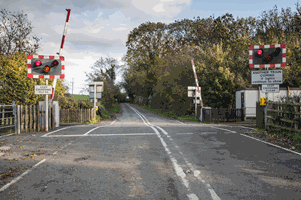
B
C
D
Correct Answer: C
Explanation: At level crossings the red lights flash before and when the barrier is down. At most crossings an amber light will precede the red lights. You must stop behind the white line unless you have already crossed it when the amber light comes on. NEVER zigzag around half-barriers.
Explanation: At level crossings the red lights flash before and when the barrier is down. At most crossings an amber light will precede the red lights. You must stop behind the white line unless you have already crossed it when the amber light comes on. NEVER zigzag around half-barriers.
20. You are waiting at a level crossing. A train has passed but the lights keep flashing. You must
Mark one answer
B
C
D
Correct Answer: A
Explanation: If the lights at a level crossing continue to flash after a train has passed, you should still wait as there might be another train coming. Time seems to pass slowly when you're held up in a queue. Be patient and wait until the lights stop flashing.
Explanation: If the lights at a level crossing continue to flash after a train has passed, you should still wait as there might be another train coming. Time seems to pass slowly when you're held up in a queue. Be patient and wait until the lights stop flashing.
Correct Answer: C
Explanation: Urban clearways are provided to keep traffic flowing at busy times. You may stop only briefly to set down or pick up passengers. Times of operation will vary from place to place so always check the signs.
Explanation: Urban clearways are provided to keep traffic flowing at busy times. You may stop only briefly to set down or pick up passengers. Times of operation will vary from place to place so always check the signs.
Correct Answer: A
Explanation: Although a convex mirror gives a wide view of the scene behind, you should be aware that it will not show you everything behind or to the side of the vehicle. Before you move off you will need to check over your shoulder to look for anything not visible in the mirrors.
Explanation: Although a convex mirror gives a wide view of the scene behind, you should be aware that it will not show you everything behind or to the side of the vehicle. Before you move off you will need to check over your shoulder to look for anything not visible in the mirrors.
Correct Answer: A, B, F
Explanation: Exhaust emissions are harmful to health. Together with vibration from heavy traffic this can result in damage to buildings. Most petrol and diesel fuels come from a finite and non-renewable source. Anything you can do to reduce your use of these fuels will help the environment.
Explanation: Exhaust emissions are harmful to health. Together with vibration from heavy traffic this can result in damage to buildings. Most petrol and diesel fuels come from a finite and non-renewable source. Anything you can do to reduce your use of these fuels will help the environment.
Correct Answer: D
Explanation: In windy conditions, care must be taken on exposed roads. A strong gust of wind can blow you off course. Watch out for other road users who are particularly likely to be affected, such as cyclists, motorcyclists, high-sided lorries and vehicles towing trailers.
Explanation: In windy conditions, care must be taken on exposed roads. A strong gust of wind can blow you off course. Watch out for other road users who are particularly likely to be affected, such as cyclists, motorcyclists, high-sided lorries and vehicles towing trailers.
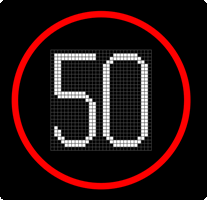
B
C
D
Correct Answer: A
Explanation: A mandatory speed limit sign above the hard shoulder shows that it can be used as a running lane between junctions. You must stay within the speed limit. Look out for vehicles that may have broken down and could be blocking the hard shoulder.
Explanation: A mandatory speed limit sign above the hard shoulder shows that it can be used as a running lane between junctions. You must stay within the speed limit. Look out for vehicles that may have broken down and could be blocking the hard shoulder.
26. As well as planning your route before starting a journey, you should also plan an alternative route. Why is this?
Mark one answer
B
C
D
Correct Answer: D
Explanation: It's a good idea to plan an alternative route in case your original route is blocked for any reason. You're less likely to feel worried and stressed if you've got an alternative in mind. This will enable you to concentrate fully on your driving or riding. Always carry a map that covers the area you will travel in.
Explanation: It's a good idea to plan an alternative route in case your original route is blocked for any reason. You're less likely to feel worried and stressed if you've got an alternative in mind. This will enable you to concentrate fully on your driving or riding. Always carry a map that covers the area you will travel in.
27. You are waiting to turn right at the end of a road. Your view is obstructed by parked vehicles. What should you do?
Mark one answer
B
C
D
Correct Answer: B
Explanation: At junctions your view is often restricted by buildings, trees or parked cars. You need to be able to see in order to judge a safe gap. Edge forward slowly and keep looking all the time. Don't cause other road users to change speed or direction as you emerge.
Explanation: At junctions your view is often restricted by buildings, trees or parked cars. You need to be able to see in order to judge a safe gap. Edge forward slowly and keep looking all the time. Don't cause other road users to change speed or direction as you emerge.
Correct Answer: B
Explanation: There are some crossings where cycle routes lead the cyclists to cross at the same place as pedestrians. These are called toucan crossings. Always look out for cyclists, as they're likely to be approaching faster than pedestrians.
Explanation: There are some crossings where cycle routes lead the cyclists to cross at the same place as pedestrians. These are called toucan crossings. Always look out for cyclists, as they're likely to be approaching faster than pedestrians.
Correct Answer: C
Explanation: It's important that people at the scene of a collision do not create further risk to themselves or others. If the incident is on a motorway or major road, traffic will be approaching at speed. Do not put yourself at risk when trying to help casualties or warning other road users.
Explanation: It's important that people at the scene of a collision do not create further risk to themselves or others. If the incident is on a motorway or major road, traffic will be approaching at speed. Do not put yourself at risk when trying to help casualties or warning other road users.
Correct Answer: C
Explanation: Keeping casualties or witnesses calm is important, but never offer a cigarette because of the risk of fire. Bear in mind they may be in shock. Don't offer an injured person anything to eat or drink. They may have internal injuries or need surgery.
Explanation: Keeping casualties or witnesses calm is important, but never offer a cigarette because of the risk of fire. Bear in mind they may be in shock. Don't offer an injured person anything to eat or drink. They may have internal injuries or need surgery.
31. At a collision you suspect a casualty has back injuries. The area is safe. You should
Mark one answer
B
C
D
Correct Answer: B
Explanation: Talk to the casualty and keep them calm. Do not attempt to move them as this could cause further injury. Call an ambulance at the first opportunity.
Explanation: Talk to the casualty and keep them calm. Do not attempt to move them as this could cause further injury. Call an ambulance at the first opportunity.
32. You are involved in a collision. Because of this which THREE of these documents may the police ask you to produce?
Mark three answers
B
C
D
E
F
Correct Answer: A, B, C
Explanation: You MUST stop if you have been involved in a collision which results in injury or damage. The police may ask to see your documents at the time or later at a police station.
Explanation: You MUST stop if you have been involved in a collision which results in injury or damage. The police may ask to see your documents at the time or later at a police station.
33. A single carriageway road has this sign. What is the maximum permitted speed for a car towing a trailer?
Mark one answer
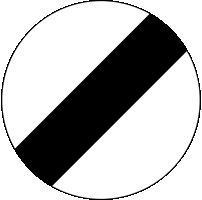
B
C
D
Correct Answer: C
Explanation: When towing trailers, speed limits are also lower on dual carriageways and motorways. These speed limits apply to vehicles pulling all sorts of trailers including caravans, horse boxes etc.
Explanation: When towing trailers, speed limits are also lower on dual carriageways and motorways. These speed limits apply to vehicles pulling all sorts of trailers including caravans, horse boxes etc.
Correct Answer: B
Explanation: When there's queuing traffic ahead and you have to slow down or even stop, showing your hazard warning lights will alert following traffic to the hazard. Don't forget to switch them off as the queue forms behind you.
Explanation: When there's queuing traffic ahead and you have to slow down or even stop, showing your hazard warning lights will alert following traffic to the hazard. Don't forget to switch them off as the queue forms behind you.
35. You are on a long, downhill slope. What should you do to help control the speed of your vehicle?
Mark one answer
B
C
D
Correct Answer: C
Explanation: Selecting a low gear when travelling downhill will help you to control your speed. The engine will assist the brakes and help prevent your vehicle gathering speed.
Explanation: Selecting a low gear when travelling downhill will help you to control your speed. The engine will assist the brakes and help prevent your vehicle gathering speed.
36. Anti-lock brakes prevent wheels from locking. This means the tyres are less likely to
Mark one answer
B
C
D
Correct Answer: C
Explanation: If an anti-lock braking system is fitted it activates automatically when maximum braking pressure is applied or when it senses that the wheels are about to lock. It prevents the wheels from locking so you can continue to steer the vehicle during braking. It does not remove the need for good driving practices such as anticipation and correct speed for the conditions.
Explanation: If an anti-lock braking system is fitted it activates automatically when maximum braking pressure is applied or when it senses that the wheels are about to lock. It prevents the wheels from locking so you can continue to steer the vehicle during braking. It does not remove the need for good driving practices such as anticipation and correct speed for the conditions.
Correct Answer: A
Explanation: Driving at a slow speed in a high gear will reduce the likelihood of wheel-spin and help your vehicle maintain the best possible grip.
Explanation: Driving at a slow speed in a high gear will reduce the likelihood of wheel-spin and help your vehicle maintain the best possible grip.
38. You are travelling along this narrow country road. When passing the cyclist you should go
Mark one answer

B
C
D
Correct Answer: C
Explanation: Look well ahead and only pull out if it is safe. You will need to use all of the road to pass the cyclist, so be extra-cautious. Look out for entrances to fields where tractors or other farm machinery could be waiting to pull out.
Explanation: Look well ahead and only pull out if it is safe. You will need to use all of the road to pass the cyclist, so be extra-cautious. Look out for entrances to fields where tractors or other farm machinery could be waiting to pull out.
Correct Answer: B
Explanation: Look well ahead and read any road signs as you drive. They are there to inform you of what is ahead. In this case you may need to slow right down and change direction. Make sure you can take whatever action is necessary in plenty of time. Check your mirrors so you know what is happening around you before you change speed or direction.
Explanation: Look well ahead and read any road signs as you drive. They are there to inform you of what is ahead. In this case you may need to slow right down and change direction. Make sure you can take whatever action is necessary in plenty of time. Check your mirrors so you know what is happening around you before you change speed or direction.
Correct Answer: A, B, F
Explanation: The licensing authority need to keep their records up to date. They send out a reminder when your vehicle excise licence (road tax) is due for renewal and need your current address to send this to you. Every vehicle in the country is registered, so it's possible to trace its history.
Explanation: The licensing authority need to keep their records up to date. They send out a reminder when your vehicle excise licence (road tax) is due for renewal and need your current address to send this to you. Every vehicle in the country is registered, so it's possible to trace its history.
41. Which instrument panel warning light would show that headlights are on full beam?
Mark one answer
B
C
D
Correct Answer: A
Explanation: You should be aware of where all the warning lights and visual aids are on the vehicle you are driving. If you are driving a vehicle for the first time you should take time to check all the controls.
Explanation: You should be aware of where all the warning lights and visual aids are on the vehicle you are driving. If you are driving a vehicle for the first time you should take time to check all the controls.
Correct Answer: A
Explanation: When driving a motor car, a learner driver who holds a provisional driving licence must
- display red L plates (or D plates in Wales) to the front and rear of the vehicle
- be insured to drive the vehicle
- be accompanied by someone who's at least 21 years old and who has held for at least three years (and still holds) a full licence for the category of vehicle being driven.
Explanation: When driving a motor car, a learner driver who holds a provisional driving licence must
- display red L plates (or D plates in Wales) to the front and rear of the vehicle
- be insured to drive the vehicle
- be accompanied by someone who's at least 21 years old and who has held for at least three years (and still holds) a full licence for the category of vehicle being driven.
Correct Answer: D
Explanation: The vehicle watch scheme helps reduce the risk of having your car stolen. By displaying high visibility vehicle watch stickers in your car you are inviting the police to stop your vehicle if seen in use between midnight and 5 am.
Explanation: The vehicle watch scheme helps reduce the risk of having your car stolen. By displaying high visibility vehicle watch stickers in your car you are inviting the police to stop your vehicle if seen in use between midnight and 5 am.
44. You are not sure if your cough medicine will affect you. What TWO things should you do?
Mark two answers
B
C
D
Correct Answer: B, C
Explanation: If you're taking medicine or drugs prescribed by your doctor, check to ensure that they won't make you drowsy. If you forget to ask at the time of your visit to the surgery, check with your pharmacist. Some over-the-counter medication can also cause drowsiness. Read the label and don't drive if you are affected.
Explanation: If you're taking medicine or drugs prescribed by your doctor, check to ensure that they won't make you drowsy. If you forget to ask at the time of your visit to the surgery, check with your pharmacist. Some over-the-counter medication can also cause drowsiness. Read the label and don't drive if you are affected.
Correct Answer: B
Explanation: The interior mirror of most vehicles can be set to the anti dazzle position. You will still be able to see the lights of the traffic behind you, but the dazzle will be greatly reduced.
Explanation: The interior mirror of most vehicles can be set to the anti dazzle position. You will still be able to see the lights of the traffic behind you, but the dazzle will be greatly reduced.
46. You are driving down a steep hill. Why could keeping the clutch down or rolling in neutral for too long be dangerous?
Mark one answer
B
C
D
Correct Answer: D
Explanation: Driving in neutral or with the clutch down for long periods is known as 'coasting'. There will be no engine braking and your vehicle will pick up speed on downhill slopes. Coasting can be very dangerous because it reduces steering and braking control.
Explanation: Driving in neutral or with the clutch down for long periods is known as 'coasting'. There will be no engine braking and your vehicle will pick up speed on downhill slopes. Coasting can be very dangerous because it reduces steering and braking control.
Correct Answer: B
Explanation: Ecosafe driving is all about becoming a more environmentally-friendly driver. This will make your journeys more comfortable as well as considerably reducing your fuel bills and reducing emissions that can damage the environment.
Explanation: Ecosafe driving is all about becoming a more environmentally-friendly driver. This will make your journeys more comfortable as well as considerably reducing your fuel bills and reducing emissions that can damage the environment.
Correct Answer: C
Explanation: After passing your practical driving test you can take further training. This is known as the Pass Plus scheme. It is designed to improve your basic driving skills and involves a series of modules including night time and motorway driving. The sort of things you may not have covered whilst learning.
Explanation: After passing your practical driving test you can take further training. This is known as the Pass Plus scheme. It is designed to improve your basic driving skills and involves a series of modules including night time and motorway driving. The sort of things you may not have covered whilst learning.
49. You are braking on a wet road. Your vehicle begins to skid. It does not have anti-lock brakes. What is the FIRST thing you should do?
Mark one answer
B
C
D
Correct Answer: D
Explanation: If the skid has been caused by braking too hard for the conditions, release the brake. You may then need to reapply and release the brake again. You may need to do this a number of times. This will allow the wheels to turn and so limit the skid. Skids are much easier to get into than they are to get out of. Prevention is better than cure. Stay alert to the road and weather conditions. Drive so that you can stop within the distance you can see to be clear.
Explanation: If the skid has been caused by braking too hard for the conditions, release the brake. You may then need to reapply and release the brake again. You may need to do this a number of times. This will allow the wheels to turn and so limit the skid. Skids are much easier to get into than they are to get out of. Prevention is better than cure. Stay alert to the road and weather conditions. Drive so that you can stop within the distance you can see to be clear.
50. Which THREE of these items should you carry for use in the event of a collision?
Mark three answers
B
C
D
E
F
Correct Answer: B, C, F
Explanation: Used correctly, these items can provide invaluable help in the event of a collision or breakdown. They could even save a life.
Explanation: Used correctly, these items can provide invaluable help in the event of a collision or breakdown. They could even save a life.



